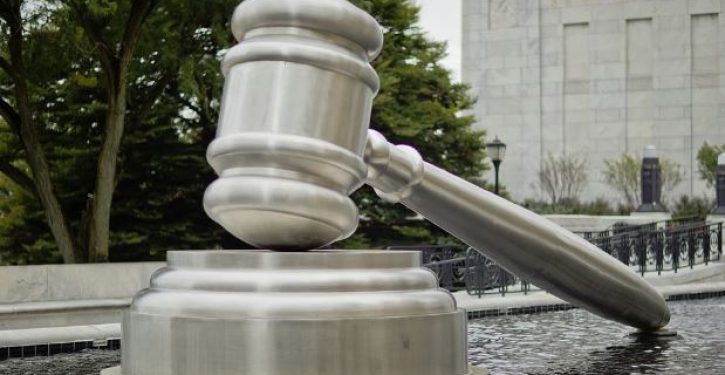
Self-styled criminal justice reformers peddle false claims that racism is prevalent in every aspect of the criminal justice system, and that it is biased against women. The reality is that it is heavily biased in favor of women, not against them: There is a massive, statistically significant gender bias in favor of female defendants compared to similarly-situated male defendants. And while there are certainly instances of discrimination against black people in areas like traffic stops, studies that allege statistically significant racial bias in criminal sentencing typically contain obvious flaws that raise questions not just about their methodology, but the good faith of their authors. Such studies seem designed to reach a pre-determined conclusion, in ignoring relevant variables (such as prior offenses), or treating offenses of very different severity as if they were similar offenses.
I say this as someone who has read innumerable studies about the role of race and gender in the criminal justice system, and has the expertise to assess such studies. I took graduate and undergraduate level statistics courses at the University of Virginia before attending Harvard Law School. And unlike many liberal arts majors who write about “criminal justice reform” but don’t understand what statistics actually mean, I am comfortable with math and statistics: I earned As in college classes in statistics, econometrics, calculus, and differential equations. I also worked briefly for the Bureau of Labor Statistics.
Women have a massive advantage in the criminal justice system. As the University of Michigan noted in November 2012, “If you’re a criminal defendant, it may help a lot to be a woman…Prof. [Sonja] Starr’s recent paper, ‘Estimating Gender Disparities in Federal Criminal Cases,’ looks closely at a large dataset of federal cases, and reveals some significant findings. After controlling for the arrest offense, criminal history, and other prior characteristics, ‘men receive 63% longer sentences on average than women do,’ and ‘[w]omen are twice as likely to avoid incarceration if convicted.'” (See Sonja B. Starr, “Estimating Gender Disparities in Federal Criminal Cases,” 17 American Law & Econ. Rev. 127 (2015)).
Will this presidential election be the most important in American history?
Women receive far shorter sentences than similarly-situated men in the criminal justice system, especially for crimes committed against family members. For example, the federal Bureau of Justice Statistics noted in 1995, that the “average prison sentence for unprovoked wife defendants [who kill their husbands without provocation] was 7 years, or 10 years shorter than the average 17 years for unprovoked husband defendants.” (See Patrick A. Langan, Ph.D, “Spouse Murder Defendants in Large Urban Counties,” Bureau of Justice Statistics, Sept. 1995, at pg. 3). For links to additional research showing a gender bias in favor of women, and a potential psychological explanation for some of that bias, see this link.
Yet, newspapers and TV almost never mention these studies showing gender bias against males. Instead, they constantly tout false claims that racial disparities in the criminal justice system are all due to racism, rather than the higher black crime rate. The New York Times, for example, glowingly featured on the front page of its web site the claim by Dr. Ibrahim X. Kendi that “when I see racial disparities, I see racism.” It did so even the claim that racism causes all racial disparities is manifestly contrary to reality. Federal courts have recognized that higher black rates of being arrested, convicted, or suspended from school can simply reflect a higher black crime or misbehavior rate. As the Fourth Circuit Court of Appeals put it, a “disparity” in the school suspension rate does not “constitute discrimination.” (See Belk v. Charlotte Mecklenburg Board of Education, 269 F.3d 305, 332 (4th Cir. 2001)).
Similarly, the U.S. Supreme Court rejected a bias claim based on the higher black arrest rate in 1996, noting in its 8-to-1 ruling that there is no legal “presumption that people of all races commit all types of crimes” at the same rate. Such a presumption is “contradicted by” real world data, it observed. For example, “more than 90% of” convicted cocaine traffickers “were black” in 1994, while “93.4% of convicted LSD dealers were white.” (See United States v. Armstrong, 517 U.S. 456 (1996)). Neither of these percentages tracks the percentages of whites and blacks in the general population, and racial bias obviously did not cause the disproportionately high arrest rate of whites for LSD trafficking, given the fact that cops themselves were mostly white. Thus, racial disproportionality obviously reflects differential crime rates.
It is simply not true that racism is everywhere in the criminal justice system, or even that all state criminal justice systems manifest racism to any statistically significant extent in sentencing. The RAND Corporation statistical expert Dr. Stephen P. Klein, a center-left researcher who exposed shenanigans by a Republican education secretary, looked carefully at California’s state criminal justice system and, controlling for relevant variables, found that criminal sentencing in California was racially fair and non-discriminatory, overall, and that blacks and whites in California who are similarly-situated got very similar sentences. (See Stephen P. Klein, et al., “Race and Imprisonment Decisions in California,” 247 Science 812 (1990)).
Similarly, a 1991 RAND Corporation study of adult robbery and burglary defendants in 14 large U.S. cities found that a defendant’s race or ethnic group bore almost no relation to conviction rates, sentencing severity, or other key measures. In 1994, federal government statistician Patrick A. Langan analyzed data on 42,500 defendants in the nation’s 75 largest counties and found “no evidence that, in the places where blacks in the United States have most of their contacts with the justice system, that system treats them more harshly than whites.” As he noted, “No Racism in the Justice System,” “Many studies have been conducted that show no bias in the arrest, prosecution, adjudication, and sentencing of blacks,” while “other studies show possible evidence of bias.”
Similarly, the fact that African-Americans are convicted and incarcerated at a higher rate than whites is primarily due to the higher black crime rate, and victim reporting of such crimes when they occur, not police racism. Crime is heavily black-on-black, and black victims of violence crimes disproportionately identify their assailant as black. As the Bureau of Justice Statistics explains, most crimes are committed mostly between members of the same racial group, and this is true for “rape or sexual assault,” “simple assault,” “aggravated assault,” and indeed, “all types of violent crime except robbery,” which is disproportionately committed by blacks against non-blacks. (See Race and Hispanic Origin of Victims and Offenders, 2012-2015). Similarly, PolitiFact noted that between 2010 and 2013, “92 percent of blacks who were murdered were killed by other blacks.”
Higher black arrest rates are due to victims (disproportionately black) identifying their assailant as black. As City Journal notes:
The victims of violent crime in New York City identify their assailants as black 62 percent of the time. Blacks, in other words, are committing a disproportionate amount of violent crime compared to their representation in the population — and that’s according to the victims themselves.
No one has ever explained why black victims would fabricate crimes by blacks, rather than whites. For example, 43.7% of all rapists in state prisons were black, according to a 1997 report by the Bureau of Justice Statistics, even though blacks are only 13% of the general population. [See Lawrence A. Greenfeld, Statistician, Bureau of Justice Statistics, Sex Offenses and Offenders (Feb. 1997) (NCJ-163392)]. As a lawyer noted in 2017, “The people they raped were disproportionately other black people who reported the offense, eliminating racial bias as a factor in reporting.”
Trying to eliminate this racial “disparity,” as Dr. Kendi seeks to do, could lead to unconstitutional racial quotas. Demanding equalization of punishment rates is an unconstitutional racial quota. For example, a federal appeals court unanimously struck down a rule that forbade a “school district to refer a higher percentage of minority students than of white students for discipline unless the district purges all ‘subjective’ criteria from its disciplinary code.”
As the court noted, this simply ignored students’ actual conduct, and the fact that “important disciplinary criteria (such as disrupting classes) are unavoidably judgmental and hence ‘subjective.'” As the court explained, “Racial disciplinary quotas violate equity in its root sense. They entail either systematically overpunishing the innocent or systematically underpunishing the guilty. They place race at war with justice. They teach schoolchildren an unedifying lesson of racial entitlements. And they incidentally are inconsistent with” the requirement “that discipline be administered without regard to race or ethnicity.” (See People Who Care v. Rockford Board of Education, 111 F.3d 528, 538 (7th Cir. 1997)).
Higher black arrest and incarceration rates are falsely depicted as the “New Jim Crow,” by people who seek to reduce sentences for violent crimes. That gets history exactly backwards. Short sentences for crimes committed by blacks against blacks were the norm under Jim Crow, and reformers sought to end that. A young black lawyer in Missouri, Theodore McMillian, successfully fought to end the evil local practice of letting blacks who kill other blacks serve just a year in jail. He was a civil-rights trailblazer, later the first African American to serve on the Missouri Court of Appeals, and the first African American to serve as a United States Circuit Judge on the Eighth Circuit. Reducing sentences for violent crimes committed by blacks (which are disproportionately committed against other blacks) is a classic example of the “soft bigotry of low expectations.”
Watering down punishment disproportionately harms innocent African-Americans, because so much crime and violence are black-on-black. After suspensions were curbed in a large urban school system, the Manhattan Institute’s Max Eden found that “schools where more than 90% of students were minorities experienced the worst” effects on school climate and safety. Indeed, the harm from curbing suspensions had “a disparate impact by race and socioeconomic status.” Eden noted in the New York Post that another “study by a University of Georgia professor found that efforts to decrease the racial-suspension gap actually increase the racial achievement gap.” Joshua Kinsler found that “in public schools with discipline problems, it hurts those innocent African American children academically to keep disruptive students in the classroom,” and “cutting out-of-school suspensions in those schools widens the black-white academic achievement gap.”
As noted above, I have read many studies about the role of racial bias in the criminal justice system. I did so with an open mind; indeed, I was eager to find evidence of such bias, if it existed.
Why did I begin doing so? I was representing a black student being sued under the Violence Against Women Act, which was passed based partly on the (false) premise that the criminal justice system discriminates against women. I wanted to find evidence that other groups, not just women, were being discriminated against, so that if the courts let the federal government federalize violence against women, it would set a precedent that the federal government could federalize violence against a vast array of other groups, such as racial minorities.
But I couldn’t find the proof of systemic racism I was seeking, because it didn’t exist. What I found was that many studies rejected claims of systemic racism, while others, which purported to find such racism, had serious flaws, such as omitting, or failing to properly take into account, major variables, which would prevent them from even being admissible evidence of discrimination under the Supreme Court’s decision in Bazemore v. Friday, 478 U.S. 385 (1986) and court rulings like Smith v. VCU, 84 F.3d 672 (4th Cir. 1996) and People Who Care v. Rockford Board of Education, 111 F.3d 528, 537 (7th Cir. 1997) (rejecting racial achievement gap study that accounted for being poor but not degree of poverty)).
(My failure to find such evidence of systemic racism was not due to a lack of skill as a researcher. Indeed, the Fourth Circuit Court of Appeals relied on my careful research in striking down Subtitle II-C of the Violence Against Women Act. I brought to the court’s attention previously obscure legislative history behind the Fourteenth Amendment, such as statements by members of the Congress that passed it. I did so by getting my boss, the veteran constitutional lawyer Michael Rosman, to put the results of my research into the defendant’s court briefs. The appeals court cited the results of that research in finding that Congress’s power under Section 5 of the Fourteenth Amendment did not give it the power to regulate private conduct, even though this finding wascontrary to dictum from the late 20th century Supreme Court. The Supreme Court then upheld the court’s ruling striking down that provision of VAWA, in a close 5-to-4 ruling. That ruling was also one of only two Supreme Court decisions in over 60 years to strike down a statute passed by Congress as exceeding Congress’s power under the Commerce Clause. See United States v. Morrison, 529 U.S. 598 (2000) (affirming the Fourth Circuit’s decision in Brzonkala v. VPI, 169 F.3d 820 (4th Cir. 1999)).
Racism persists in some facets of the justice system. Conservative African-Americans like Jason Riley of the Manhattan Institute, and Senator Tim Scott (R-SC), describe repeated unnecessary traffic stops by cops that a white person would less likely have been subjected to. Statistically-significant levels of racial bias have been detected in police stops. Cops seem to be using people’s race as a proxy for whether they may be up to no good. I hope that such discriminatory practices will someday end.
But such practices shed little light on other areas like criminal sentencing, where there is more time and information on which to make a decision. People are much more likely to use race as a proxy in low-stakes, rapid decision-making based on little more than a hunch, such as police stops or stop-and-frisk searches (where a cop may know little about the person being searched other than their race), than in more serious, individualized decisions like criminal sentencing (which requires much more evidence, leaving fewer gaps to be filled by hunches, such as subconscious racial bias, and allows more time for careful thinking before action).
Arrests are also less likely to be influenced by race, because they legally cannot be based on little more than a hunch, and commonly occur after a victim identifies the specific perpetrator (leaving no room for the use of race as a proxy). Arrests and convictions are generally legitimate, and not tainted by racism.
Bias simply does not operate the same way in low-stakes, impersonal situations (where superficial characteristics are often used as a proxy) as in high-stakes, more individualized decision-making, where race or other superficial characteristics are much less likely to be used as a proxy. For example, a person who is biased against people who have visible tattoos may avoid sitting next to strangers wearing tattoos on the bus, but probably won’t refuse to hire someone solely because they have a tattoo, if their résumé also shows that they have all the needed qualifications to fill a long-vacant position.




